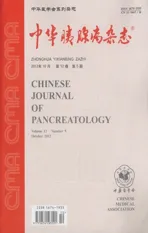miR-155与胰腺癌关系研究进展
2012-01-21李小溪刘俊
李小溪 刘俊
·综述与讲座·
miR-155与胰腺癌关系研究进展
李小溪 刘俊
MicroRNAs(miRNAs)是一类由18~24个核苷酸构成的单链RNA,属于非编码蛋白RNA。目前认为,miRNA通过与靶基因mRNA的3′端非编码区(3′-untranslational region, UTR)结合,抑制mRNA的转录,从而调节靶基因的功能[1]。
在miRNA发现之前,有研究发现B细胞整合簇(B cell integration cluster,BIC)的非编码RNA可以加速鸡的淋巴瘤生成[2]。2005年,Eis等[3]研究发现,BIC是miR-155的前体,且后者在包括弥漫性大B细胞淋巴瘤(DLBCL)等多种B细胞瘤表达增加,并且与预后有一定的相关性。其后的一系列研究发现,miR-155在B细胞淋巴瘤、肺癌、乳腺癌、结肠癌中均有高表达[4-5]。miR-155通过调节T细胞和B细胞以及髓系细胞的激活及相关免疫反应,参与慢性炎症与癌症发生的中间环节[6-8]。本文就miR-155 在胰腺癌中的研究进展作一综述。
一、miR-155在胰腺癌前病变及胰腺癌中的表达
胰腺癌的发生是一个多步骤的过程,包括一系列癌前病变如上皮内瘤变(PanIN)以及导管内乳头状黏液性肿瘤(intraductal papillary mucinous neoplasm,IPMN)等。在这些癌前病变中,miR-155有不同程度的高表达,提示miR-155的异常表达参与肿瘤发生的多步骤过程。Ryu等[9]应用qRT-PCR的方法检测了36例胰腺上皮内瘤变的组织标本,发现miR-155在PanIN-2和PanIN-3中也较正常组织过量表达,分别增加2.6倍和7.4倍。Habbe等[10]应用相似的方法检测了5例胰腺IPMN中miRNA的表达,发现miR-155的表达与正常组织相比增加11.6倍,在相应的胰液中,miR-155的表达也较正常组织显著升高。原位杂交法也证实miR-155在IPMN的表达与正常组织有显著性差异。
多项研究表明miR-155在胰腺导管腺癌(pancreatic ductal adenocarcinoma,PDAC)组织中表达显著增加。Lee等[11]和Szafranska等[12]应用定量RT-PCR技术检测胰腺癌组织,发现miR-155在PDAC中相对于正常组织表达分别上调了14和10倍,而在慢性胰腺炎中miR-155的表达介于正常组织与PDAC组织之间。Bloomston等[13]应用芯片显着性分析(significance analysis of microarray, SAM)方法测定胰腺癌、慢性胰腺炎和正常胰腺组织中miR-155表达,发现胰腺癌组织miR-155表达较其他组织明显升高;进而应用RT-PCR检测8个胰腺癌标本和8个对应的良性胰腺标本,也显示胰腺癌miR-155表达显著增加。Sadakari等[14]检测PDAC患者的癌组织和胰液中miR-155的表达,发现癌组织和胰液中的miR-155表达较正常组织及慢性胰腺炎组织均增加。Lee等[11]检测了9个胰腺癌细胞株中miR-155的表达,并用分类预测分析(prediction analysis of micro-arrays,PAM)的方法对数据进行处理,发现miR-155在PDAC中相对于正常组织表达上调了14倍。
二、miR-155在其他胰腺肿瘤中的表达
Roldo等[15]应用芯片及northern blot技术检测了12 例非胰腺肿瘤组织和44例原发胰腺肿瘤标本(12例胰岛细胞瘤、28例非功能性胰腺内分泌瘤和4例腺泡瘤),结果显示瘤组织miR-155的表达量较非肿瘤组织均有降低,但各肿瘤中的表达无明显差异。因此,他们认为miR-155的表达仅可作为区分肿瘤与非肿瘤的指标之一。
三、miR-155与胰腺癌的发生
1.miR-155的生物作用:miR-155可以通过多种通路调控多种免疫基因,对免疫系统产生多重作用,引起基因沉默、染色体重构和相关免疫逃避的启动,参与肿瘤的发生[16]。miR-155还被证明可以阻断DNA错配修复机制(MMR),增加自发性基因突变的频率[17]。
2.miR-155的靶蛋白:Greither等[18]发现PDAC中miR-155与miR-222共享许多靶蛋白,调节细胞的生长,如MYBL1、TP53INP1、RAB1A、VEZF1、MAP3K10、SOX1和NOVA1,并发现PDAC中BACH1和HIF-1α的异常表达受miR-155的直接调节。TP53INP1是p53的靶基因之一,在PDAC中表达量显著降低,且在癌前病变PanIN-2中也显著减少,并且在PDAC转移灶中表达缺失。Gironella等[19]用ponasterone A(PonA)处理MiaPaCa2细胞株后其TP53INP1表达增加,种植于裸鼠后不形成肿瘤灶。进一步研究证实,miR-155可以与TP53INP1的3′UTR段结合,抑制TP53INP1的表达,而抑制miR-155后,TP53INP1可重新表达。提示miR-155通过抑制TP53INP1的表达,从而抑制TP53INP1的抑癌作用,促进胰腺癌的发生。
3.miR-155与其他miRNA的相互作用:Greither等[18]发现,miR-155的表达与miR-210、miR-203和miR-222有明显的相关性,提示这些miRNA之间可能存在协同作用,共同对miRNA进行转录后调控,或者有相互稳定的作用。但具体机制仍有待进一步研究。
4.miR-155的相关调节通路:有许多信号分子在胰腺癌中可调节miR-155的表达。Xia等[20]证明,SMG-1相关通路、MEK1/2以及JNK相关通路均为吉西他滨升高BIC的信号机制,提示存在多条调节miR-155通路。
四、miR-155在胰腺癌诊治中的应用价值
1.miR-155与早期诊断:研究显示,在PanIN-2、PanIN-3以及IPMN中,miR-155的表达量均较正常组织显著性增高[13-14],提示检测组织中miR-155的表达可提高胰腺癌的诊断率。但Kong等[21]报道,慢性胰腺炎患者血清miR-155也显著升高,诊断胰腺癌的特异性不高。
Sadakari等[14]检测PDAC患者胰液中miR-155水平,证明胰液的miR-155水平较正常组织及慢性胰腺炎组织均升高,但其水平与胰液的细胞学检查结果并无明显相关性。
Ryu等[22]检测了黏液性囊腺瘤胰腺(MCN)和导管内乳头状黏液性肿瘤(IPMN)的囊液中miR-155的表达,发现囊液中miR-155的表达与非黏液性组织并无显著差异,提示囊液并不是理想的诊断标本。
为了提高检测的特异性,Roldo等[15]建议miR-155下调联同miR-103和miR-107的上调可作为胰腺内分泌瘤与腺泡瘤区分正常组织的标志,但对病变性质无鉴别诊断价值。
2.miR-155与患者预后判断:2010年Greither等[18]分析了56例PDAC患者的癌组织标本,发现miR-155高表达患者的癌症相关病死率明显升高,但miR-155对患者预后的影响与疾病进展程度无关。此外还发现,miR-155、miR-203、miR-210和miR-222同时升高者的病死率较单独miR-155升高患者明显增加。
3.miR-155与胰腺癌的治疗:Xia等[20]应用吉西他滨处理胰腺癌细胞PANC1,结果细胞的BIC表达增加,应用MEK1/2、JNK的抑制剂、PI3K抑制剂渥曼青霉素可以上调BIC的表达;而敲除PI3K的相关激酶,生殖器形成抑制基因SMG-1是可以抑制吉西他滨上调BIC的作用。因此,在使用吉西他滨等药物的同时合并使用BIC的抑制剂,可减少miR-155的表达,充分发挥抗癌药物的治疗效果。
[1] Bartel DP. MicroRNAs: target recognition and regulatory functions. Cell, 2009,136: 215-233.
[2] Tam W, Ben-Yehuda D, Hayward W S. bic, a novel gene activated by proviral insertions in avian leukosis virus-induced lymphomas, is likely to function through its noncoding RNA. Mol Cell Biol, 1997, 17: 1490-1502.
[3] Eis PS, Tam W, Sun L, et al. Accumulation of miR-155 and BIC RNA in human B cell lymphomas. Proc Natl Acad Sci USA, 2005, 102: 3627-3632.
[4] Kluiver J, Poppema S, de Jong D, et al. BIC and miR-155 are highly expressed in Hodgkin, primary mediastinal and diffuse large B cell lymphomas. J Pathol, 2005, 207: 243-249.
[5] Volinia S, Calin GA, Liu CG, et al. A microRNA expression signature of human solid tumors defines cancer gene targets. Proc Natl Acad Sci USA, 2006,103: 2257-2261.
[6] Chen DF, Gong BD, Xie Q, et al. MicroRNA155 is induced in activated CD4(+) T cells of TNBS-induced colitis in mice. World J Gastroenterol, 2010,16: 854-861.
[7] Tili E,Croce CM,Michaille JJ.miR-155: on the crosstalk between inflammation and cancer.Int Rev Immunol, 2009,28: 264-284.
[8] He M, Xu Z, Ding T, et al. MicroRNA-155 regulates inflammatory cytokine production in tumor-associated macrophages via targeting C/EBPbeta. Cell Mol Immunol, 2009,6: 343-352.
[9] Ryu JK, Hong SM, Karikari CA, et al. Aberrant MicroRNA-155 expression is an early event in the multistep progression of pancreatic adenocarcinoma. Pancreatology, 2010,10: 66-73.
[10] Habbe N, Koorstra JB, Mendell JT, et al. MicroRNA miRK-155 is a biomarker of early pancreatic neoplasia. Cancer Biol Ther, 2009,8: 340-346.
[11] Lee EJ, Gusev Y, Jiang J, et al. Expression profiling identifies microRNA signature in pancreatic cancer. Int J Cancer, 2007, 120: 1046-1054.
[12] Szafranska AE, Davison TS, John J, et al. MicroRNA expression alterations are linked to tumorigenesis and non-neoplastic processes in pancreatic ductal adenocarcinoma. Oncogene, 2007, 26: 4442-4452.
[13] Bloomston M,Frankel WL, Petrocca F,et al.MicroRNA expression patterns to differentiate pancreatic adenocarcinoma from normal pancreas and chronic pancreatitis.JAMA,2007,297:1901-1908.
[14] Sadakari Y, Ohtsuka T, Ohuchida K, et al. MicroRNA expression analyses in preoperative pancreatic juice samples of pancreatic ductal adenocarcinoma. JOP, 2010,11: 587-592.
[15] Roldo C, Missiaglia E, Hagan J P, et al. MicroRNA expression abnormalities in pancreatic endocrine and acinar tumors are associated with distinctive pathologic features and clinical behavior. J Clin Oncol, 2006, 24: 4677-4684.
[16] Asirvatham AJ, Gregorie CJ, Hu Z, et al. MicroRNA targets in immune genes and the Dicer/Argonaute and ARE machinery components. Mol Immunol, 2008,45: 1995-2006.
[17] Tili E, Michaille JJ, Wernicke D, et al. Mutator activity induced by microRNA-155 (miR-155) links inflammation and cancer. Proc Natl Acad Sci USA, 2011,108: 4908-4913.
[18] Greither T, Grochola LF, Udelnow A, et al. Elevated expression of microRNAs 155, 203, 210 and 222 in pancreatic tumors is associated with poorer survival. Int J Cancer, 2010,126: 73-80.
[19] Gironella M, Seux M, Xie MJ, et al. Tumor protein 53-induced nuclear protein 1 expression is repressed by miR-155, and its restoration inhibits pancreatic tumor development . Proc Natl Acad Sci USA, 2007,104: 16170-16175.
[20] Xia QS,Ishigaki Y,Zhao X,et al.Human SMG-1 is involved in gemcitabine-induced primary microRNA-155/BIC up-regulation in human pancreatic cancer PANC1 cells.Pancreas,2011,40:55-60.
[21] Kong X, Du Y, Wang G, et al. Detection of differentially expressed microRNAs in serum of pancreatic ductal adenocarcinoma patients: miR-196a could be a potential marker for poor prognosis. Dig Dis Sci, 2011,56: 602-609.
[22] Ryu J K, Matthaei H, Dal Molin M, et al. Elevated microRNA miR-21 Levels in pancreatic cyst fluid are predictive of mucinous precursor lesions of ductal adenocarcinoma. Pancreatology, 2011,11: 343-350.
10.3760/cma.j.issn.1674-1935.2012.05.024
200080 上海,上海市第一人民医院普外科
刘俊,Email:liujun@yahoo.com.cn
2011-10-19)
(本文编辑:屠振兴)
